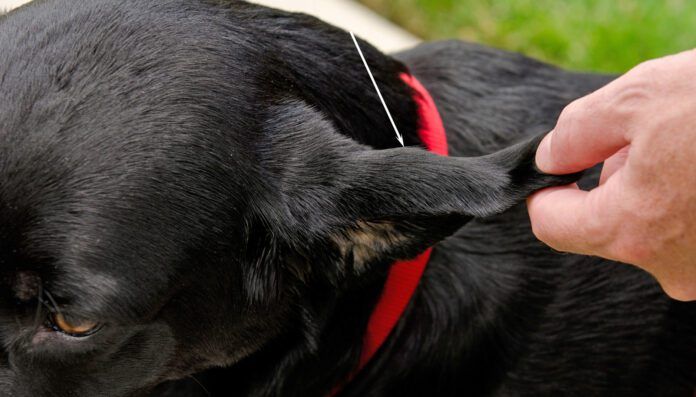You can treat a small aural (ear) hematoma on your dog at home, if necessary, but you run a real risk of ending up with an unsightly cauliflower ear (more on that below). In addition, that hematoma is painful for your dog. Frankly, treating your dog’s hematoma at home is not a good idea. The best way to treat a dog’s ear hematoma is to have it surgically repaired by your veterinarian.
What Is an Aural Hematoma?
An aural hematoma is a pocket of blood that occurs when the small capillaries inside the ear flap break. The hematoma lump will feel soft and squishy at first, becoming firm and receding over time as a clot forms and the ear heals.
An aural hematoma lump in a dog can happen for a variety of reasons. Often the dog has an itchy ear infection that causes him to scratch repeatedly at the ear, traumatizing the delicate blood vessels in the ear flap. Itchy ears due to allergies and bug bites can do the same thing.
Other potential causes include trauma from a bite wound, an object stuck inside the ear causing irritation, or a bleeding disorder.
Best Way to Treat an Aural Hematoma
The best way to treat a hematoma is to remove the blood, close the pocket of now empty space, and treat the underlying cause so that it doesn’t happen again. And you can accomplish these goals with the help of your veterinarian.
Every veterinarian has a favorite way to treat a ear hematoma, but you need to be up front about your budget limitations so your dog’s vet can choose the approach that will be the best fit for you and your dog.
The gold standard is to put the dog under anesthesia or sedation, drain the blood out of the ear using a needle or small incisions made with a scalpel, and then stitch the pocket in the ear closed with sutures through the whole ear. Closing the pocket this way makes it impossible for blood to fill the ear flap again while it is healing and encourages the development of scar tissue supporting a normal ear shape.
If your dog is calm and easy to work with, your vet may be able to drain the hematoma lump while he is awake using a large needle and a syringe. Suturing the pocket closed is not usually possible for an awake dog—that’s a lot of pokes to sit through! These dogs often need to have their hematomas drained several times over the course of a few weeks.
Some vets infuse a steroid into the ear flap after draining to address inflammation at the source.
While the ear heals, it must be protected. This is true for either a surgical repair or a basic drain. Some options to protect the ear and prevent additional trauma include wrapping the ear to the head, a No-Flap Ear Wrap, and/or an Elizabethan collar. It may take some trial and error to find the option that works best for your dog, and some dogs need multiple layers of protection.
Treating the Cause of the Hematoma Lump
To prevent a hematoma from coming back, you will need to treat the underlying cause. This is best done with the help of your vet.
Your veterinarian can swab the ear and check for an infection, then prescribe the appropriate ear meds (plus do a thorough cleaning!). If your dog has allergies, the vet can walk you through the process of managing those. Foreign bodies may be able to be flushed out or may require surgical removal. Bleeding disorders can be diagnosed with bloodwork and treated or managed appropriately.
Treating a Dog Ear Hematoma at Home
You can try to treat your dog’s aural hematoma at home, especially if it is a small hematoma and your dog’s ear is clean and healthy. This will take time, and his ear will crinkle as it heals and end up with a “cauliflower” appearance.
To encourage the blood to drain, alternate warm and cold compresses for 5 to 10 minutes each several times a day. The warm compress encourages blood flow to get fluid out of the ear flap, while the cold then slows blood flow and helps to decrease inflammation and discomfort. Be sure that warm compresses are not hot enough to burn the ear.
After each compress session, wrap the ear to your dog’s head or use a No-Flap Ear Wrap to apply pressure to the ear and protect it. An Elizabethan collar can be helpful as well.
You do also have the option of letting the hematoma heal completely on its own. This will take longer and increases the risk of a cauliflower ear. The folds from a cauliflower ear may block air flow to the ear canal and provide additional nooks and crannies for future ear infections to set up shop.
If your dog has an ear infection or if inflammation or a wound is present, he will need to see a veterinarian.


so much fantastic information on here, : D.